 |
As told by: |
Al Chafe’s Sea Tales
“I’m Al Chafe of DesRon9, in Mansfield DD 728 from ll/52 to 3/54. I was a JO3, then JO2 on Mansfield having been assigned there from a San Diego shore installation when I made 3rd Class and asked BuPers if I could now go to school to learn what it was a JO did. Shortly after I made 2nd Class, I was transferred to the cruiser Rochester because DesRon9 didn’t rate a 2nd Class journalist to write war diaries. A year later I made 1st Class and with no prospects ahead beyond Armed Services Network assignments in the Tokyo area if I promised to ship over of four years, I pulled the plug in Jan, 1955 four years after signing on.”
“Just wanted to pass on that our ‘flag office’, shared by three guys (two yeomen and myself) was up on the torpedo tube deck in an ammo locker just starboard of the #1 stack. I swear that thing was no more than 4×6′ but we got two metal desks and three chairs into it along with big file cabinet. Stayed pretty cozy in the winter with its own heater and three unwashed bodies–but it was really hell getting up onto that second deck when the rime ice was building. Used to get 8″ thick on the safety chains along the deck edges and had to be smashed off with a fire axe so the chains could be dropped to bring on stores or fuel. More than an hour’s work by two men.”
“Service on Mansfield was pretty routine (read “dull.” Our four ships, DeHaven (DD 727), Mansfield (DD 728). Lyman K. Swenson (DD 729) and Collett (DD 730), the only contiguously numbered destroyers in the fleet at that time, made up DesDiv91 while another four destroyers of the same class made up DesDiv92 (the two divisions constituting Destroyer Squadron Nine.) We split our time in Long Beach and WestPac with each half of the squadron relieving the other half. Operating with Task Force 77 off of Korea, we chased carriers as plane guards, interdicted Red Korean trains as they moved along the east coast (often sealing them in tunnels with 5″ shell fire) and spent our off time in Yokusuka and Sasebo, Japan. Very cold winters and boiling summers! Twice we dodged torpedoes launched at us from finger piers on the North Korean coast and many times we detonated free-floating mines as they bobbed into the track of Task Force 77 with its flotilla of carriers, cruisers, destroyers and auxiliaries. (Missouri and/or Wisconsin, our only two active battleships at that time also were in the Task Force and beautiful as they slashed through the deep storm seas of those Korean winters.) Anyway, fun times and adventures for a young man of those days–early 20’s and not a whole lot to do but learn.”
“Re: Mansfield photo. Must have been in her early years, judging by the radar on her upper mast because it was history when I went aboard in late ’52. (She had the rotating heavy arc by that time.) Anyway, brings great memories. I remember once we were holding speed and fuel burn tests with the squadron in 1953 as we returned from WESPAC and were between Midway and Pearl. We started out about noon with all four ships (727, 728, 729, and 730) side by side at about 15 knots and thereafter each ship added a given number of turns to the screws for the rest of the day. By sunset all four were doing about 30 knots, still side by side, in that brilliant blue tropical sea, each with a shimmering white bone-in-her-teeth as we plowed eastward. Talk about a beautiful sight! If one has any feeling for the beauty of the open sea they would have been thrilled to their socks to have seen that sight and I felt honored. We continued to “race” all night and the next morning about 5:30 I went out on deck to see who was where. There was no other ship on the horizon–not even a wisp of smoke to be seen. We were totally alone. LYMAN K. SWENSON (DD 729) was in the lead and well over the horizon, MANSFIELD, at 34.2 knots was second, and the other two straggled over the horizon behind us at various unrecalled speeds. Steaming all night at what became full speed didn’t allow for much sleep. Everything in the ship, from the watertight doors to the light bulbs was vibrating and singing its own song of protest. The props felt as though the were going to come whipping off and the hull shuddered like the dog passing razor blades. What a show! Your photo resurrected all those wonderful memories.”
[ Return to Top ] [ Sea Tales Pg.2 ] [ Sea Tales Pg.3 ] [ Sea Tales Pg.4 ] [ Sea Tales Pg.5 ]
Karl’s Sea Tales
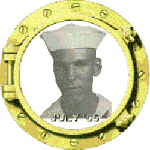
“Hard to believe 30+ years have passed since I was a boot at Great Lakes in July 1965. I wouldn’t trade my time in the Navy for anything. I’m afraid many of the younger generation of today will never experience the comradeship and bond we all share as shipmates and veterans.”
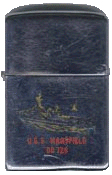 “Almost everyone who was in the Navy during my era, the 60’s, smoked cigarettes. Most of the guys on the ship had one of the infamous Zippo lighters. I remember paying $.50 a carton for Kents once we got underway heading for WestPAC. I think the going price for other brands was $1.00 per carton. When I was stationed at NSGA Bremerhaven, Germany the price was $1.50 per carton. I was smoking three packs a day. In June of 1969, I was on a plane heading for Brooklyn to be discharged. I ran out of smokes on the plane and at that time you would get a complimentary 4-pack from the airlines. I finished those and went to buy a pack when we landed at Kennedy. When I was told the price was $.65 per pack, that was it, I quit right on the spot and haven’t had a cigarette since! Maybe the price was one of the reason many of the guys got hooked on smoking. In these days of “no smoking” it sure seems funny talking about how much we used to smoke.”
“Almost everyone who was in the Navy during my era, the 60’s, smoked cigarettes. Most of the guys on the ship had one of the infamous Zippo lighters. I remember paying $.50 a carton for Kents once we got underway heading for WestPAC. I think the going price for other brands was $1.00 per carton. When I was stationed at NSGA Bremerhaven, Germany the price was $1.50 per carton. I was smoking three packs a day. In June of 1969, I was on a plane heading for Brooklyn to be discharged. I ran out of smokes on the plane and at that time you would get a complimentary 4-pack from the airlines. I finished those and went to buy a pack when we landed at Kennedy. When I was told the price was $.65 per pack, that was it, I quit right on the spot and haven’t had a cigarette since! Maybe the price was one of the reason many of the guys got hooked on smoking. In these days of “no smoking” it sure seems funny talking about how much we used to smoke.”
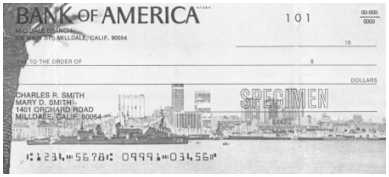
Text from article supplied by Jim Frazier
Independent Press-Telegram Long Beach, California, Sunday, June 22, 1969 –
USS Mansfield Crew Boasts Custom Checks
It wasn’t planned that way, but Bank of America is providing custom-made checks for one of the Navy’s most distinguished ships.
While both the bank and the ship’s officers and crew are delighted with the arrangement, it never would have happened if it hadn’t been for the sea trained eye of the ship’s skipper, Commander Paul Anderson of the destroyer USS Mansfield.
Last month while the Mansfield was in San Diego on a six-week refresher training program, Commander Anderson, a BankAmericard holder received a brochure advertising Bank of America’s new California scenic checks.
One of the 10 scenes is the San Diego skyline and harbor with a ship in the foreground.
Although the photograph was only one-fourth actual check size, Commander Anderson thought he recognized the barley visible number in the ship’s hull as the Mansfield’s own “728”.
WHEN THE VESSEL RETURNED to its Long Beach home port, Commander Anderson went to the bank’s Terminal Island branch and inspected a poster-size photograph of the San Diego scene. It clearly showed the pictured ship was indeed the Mansfield.
Although the Mansfield appeared in the San Diego shot purely by chance, the bank could hardly have chosen a more deserving subject.
The Mansfield has been in continuous commission for the past 25 years, undergoing heavy combat in World War II, Korea and Vietnam, and has participated in two NASA space shot recovery operations.
Recently back from two years duty in Vietnam – and scheduled to return in September – it currently holds the record for the most rounds fired by a destroyer in Vietnam and was one of the prime reasons its squadron, Destroyer Division 92, was recently cited by the Secretary of the Navy as one of the most outstanding destroyer units of the Pacific Fleet.
WHEN the bank learned of all this it made an enlargement of the San Diego check with a personal greeting from Board Chairman Louis B. Lundborg and formally presented it to Commander Anderson and his crew for the ship’s wardroom. Plans also are being made to use the photograph on the ship’s official stationery.
As things worked out, the Navy, the Mansfield and Bank of America all profited by the coincidence – and Commander Anderson’s sharp eye.
The Navy can boast that thousands of Californians will be writing their personal checks over a picture of one of its proudest ships.
The 295-man Mansfield crew can enjoy the most personalized bank checks ever offered anyone.
[ Return to Top ] [ Sea Tales Pg.2 ] [ Sea Tales Pg.3 ] [ Sea Tales Pg.4 ] [ Sea Tales Pg.5 ]
Stan’s Sea Tales
“After Lt. York (Ops Officer who replaced Lt. Henry) arrived aboard, he told RMC Cheap that he wanted to visit the radio shack. About 0830 hrs he rang the door bell. One of the RMs opened the door and he walked in. I was standing next to Chief Cheap when York looked on the bulkhead above the supervisors desk and saw the Union Pacific Railroad calendar. He asked who worked for the Union Pacific and I told him, ‘My father, Sir’. He asked, ‘Where?’ and I said, ‘Marysville, Kansas, Sir’. He said, ‘Marysville!, what’s his name?’ and I said, ‘B.E. Jaynes’. He exclaimed, ‘Trainmaster Bart Jaynes, hell yes I know him, he fired me!’ Turns out he had wrecked a UP vehicle and dad fired him for it. York’s brother still worked for UP in St. Joseph, Missouri (that was 1967). York never held that against me. When I got home in July 1967 I told this story to dad. He remembered York and got a big kick out of this. Guess it was the first time I realized that it is a Small World we live in.”
“Thought of one more thing that happened to me. I had a top secret clearance and one afternoon we received a secret message about meeting an ammo ship. I took the message around to the Comm. officer to initial it, then to Ops. Officer Lt. Henry. He wrote out to the side, ‘Weps’ and told me to have Lt. Clowe, the OOD, read and initial it. I acknowledged this and took the message up to the bridge and Lt. Clowe initialed it. I then took the message to the XO and then to Capt. Nellis. I returned to the radio shack and filed the message. No officer got a copy of a secret message unless he signed for it. The next day the sound powered phone rang in the radio shack and I answered it. Mr. Henry told me to report to his stateroom on the double. A few minutes later I arrived and Mr. Henry asked me if I recalled the secret message and I stated that I did. He asked me if Mr. Clowe had seen it and I stated he had. He then asked me to prove it. I went back to the radio shack, took the message out of the files and returned to Mr. Henry’s stateroom. He looked at the message and said, ‘Let’s go’. We walked from his stateroom, which was in the after officer’s quarters up to the wardroom. He threw open the door and Lt. Clowe was alone, having a cup of coffee. Lt. Henry stated (in a loud voice), ‘G–d–n it Wally, before you start bad mouthing my radiomen you better make damn sure you know what you’re talking about !’. He threw the message on the table in front of Lt. Clowe. Lt. Clowe looked at the message, saw his initials on it, looked at me and said, ‘Jaynes, you have my apologies’. I just said, ‘Thank you, sir’. That was one good thing about the officers and crew, there was definitely mutual respect for all. Did you know that when all of the officers were on “the beach” for liberty and a crew member saw that officer, it was alright to address each other on a ‘first name basis’? The only natural exception was Capt. Nellis, no crew member was allowed to address him in any manner except ‘Captain Nellis'”.
“Thought of something else that happened in good ol’ Subic Bay: One night almost all of the officers were in the O Club; the tables were full of empty San Miguel Beer bottles and the CIC officer started calling out coordinates. The weapons officer began throwing the bottles over the portable partitions, at other officers from other ships! Needless to say the were all “86’d”. A night or two later they were back in the O Club, when the admiral of the base walked in and his aide, a commander, called out, “Attention on deck!”. Every officer snapped to attn except for Capt. Nellis. [This part of the story was omitted per request of Capt. Nellis *Karl*] Again, all were 86’d. Capt. Nellis talked with SM1 Johnson the next day and asked Johnson if he could make a flag and the flag was to be ready to fly when we pulled out of Subic. Johnson said “no problem, Capt.” When we left Subic and the command “under way, shift colors” was given, the battle flag (yellow-gold flag with a black silhouette of a female (remember it??) and right under it was the new flag, same size as the battle flag, red flag with white lettering that read: ‘TO SUBIC WITH LOVE’ and the one finger salute!!”
And here they are. I did these animations from Capt. Nellis’s photos. *Karl*
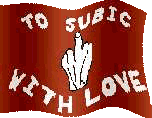 |
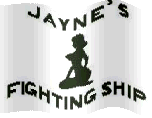 |
“Thought of a couple more things: Don’t know if you remember two radiomen, Frank “JJ” Pershing from Penn and Jim “Tex” Lilly from, where else–Texas. Unfortunately, Tex was shot and killed by his brother-in-law several years ago. My wife and I met his parents and that’s when we learned about the tragedy. Tex had suffer red the opposite of Gran Mal epilepsy due to Mansfield being hit while on Operation Sea Dragon. Tex was leaning against the bulkhead in the radio shack when the shell exploded, his head hit the bulkhead extremely hard and had some major brain damage.”
“Anyway, Tex used to work for me, he was an RMSN when I was 3rd class. One night Tex and JJ entered the radio shack and JJ was very excited. JJ was always jittery and excitable. He was upset because Tex had hit another sailor while they were on liberty in Subic Bay. JJ said, “Tex, tell Stan why you hit that guy!” Tex said, “Wall, he called me a HIC and I just had to hit him!”
Another story about JJ. We were in Yokosuka and the first class RM, Jim Wilmot, asked JJ if he was in love. JJ was really in a hurry to go on liberty and the Radio Gang had the benefit of keeping our liberty cards all the time. We did not have to turn them in. JJ said that he was really in love with a bargirl in one of the bars (but I forget which one). Wilmot asked, ‘How much in love are you, JJ?’ JJ said, ‘Man, I’m so much in love that I drag my b–ls thru 5 miles of broken glass just to hear her f–t over a telephone!!'”
“I also recall one day in the shack when Wilmot was standing in the main part of the shack and another radioman, Robert ‘Jake’ Jacobsen (from Chicago) was leaning against the supervisor’s desk. The ship took a slight roll to port and Jake lost his balance and stepped on Willy’s foot. Willy said, ‘Jacobsen, you club footed SOB, watch were you’re going!!'”
“Another radioman had a friend who was a commissaryman. One night we had fresh bread that he had brought up to the shack from the mess decks. We pulled alongside a refer ship to bring stores aboard and low and behold, but we got a load of strawberry preserves and peanut butter. Needless to say, a case of each wound up in the shack and after ‘breaking away’ from the refer, all of the radiomen had fresh bread with p-nut butter and strawberry preserves!!!”
“Twice in 1967 we had to steam 5 miles up the Saigon River from the Mekong Delta to provide NGFS since VC were over running a friendly camp. Both times we got up there about 4 or 5 pm and after the NGFS mission was over, it was too late to try to back down the river. I recall the river varied in depth from 18 ft to 118 ft and you really had to watch your sonar to avoid running aground. The next day I walked out onto the torpedo deck and saw sampans all around us and every person in those LBGBs were wearing black silk pajamas and straw hats!! I looked up to the port bridge wing and saw 2 GMs manning the .50 cal and on the weather deck, about every 15 ft was a “deck ape” holding a rifle. Same thing on the starboard side. Seems the captain had made a comment that they were fishing and we were in their fishing waters…but, if they tried to board the ship, repel boarders!! Between our first and second times there, the captain of the USS Alfred A. Cunningham ran that ship aground on the same mission and lost his command. Another ship had to go up the river to pull the Cunningham out of the mud.
*NGFS Naval Gun Fire Support
*LBGB Little Bitty Gook Boat !!
You know that an LBGB with 1 AK-47 was a PBR
If it had 1 AK-47 and a machine gun, it was a DESTROYER !!”
“I recall one day we were working with an airborne spotter. He saw 3 VC in an LBGB and gave us coordinates. We fired and he told us they were headed for shore and new coordinates–we fired again and they headed back to the boat–we fired again and we guessed we had hit them. The next day 3 PBRs pulled alongside with some Green Beret officers who were going to meet with our officers for new target info. One of the guys on the PBR asked if it was us who was shooting a some VC in an LBGB. We told them yes, but didn’t know for sure if we got them. He said that we had hit them because he saw the bodies floating by.”
“One other time working with a spotter: We had just secured from GQ on an NGFS mission when this spotter called for any Navy ship in the area. You know the ‘Old Man’ !! He jumped on the radio and acknowledged the spotter. The spotter said he had VC all over the place and needed help ASAP. The ‘Old Man’ said, ‘This is Tactics and we are enroute’. The old ship was doing all of 26 knots and just shuddering with every spin of the screws. We arrived on line and got set up with GQ, etc. and the spotter gave us coordinates and wanted HE for effect. We told him that we had just left a mission, low on HE and wanted to use some other type of ammo. He said negative, HE. Well, after telling him numerous times that we needed to use another type and that we were below our minimum quantity of HE we had to keep on board and requested we try VT Frag. He finally gave in and said OK let’s see this almighty VT of yours (he must have been a NEW spotter). We fired 6 guns — 6 salvos of VT and all he could say was, ‘G D, pour on the VT Frag !!'”
“The hurricane: We spent about a week riding it, or at least it seemed like a week. This was in 1967 off of Okinawa. We were all alone and we couldn’t get out of it. We were taking in excess of 45 degree rolls, and rumor had it that a tin can couldn’t take a roll like that without capsizing. I ran into a sailor who I had graduated from high school with in Kansas in 1964. I didn’t even know he was in the Navy. Ran into him in Subic Bay and he was on the USS Bon Homme Richard . I asked him if he had ever gotten sea sick. His reply was, “Hell yes”. I asked him how he could get sick on an aircraft carrier and he said that it went up and down and side to side. I told him that I was on a “tin can” and by the time his ship and gone up and down and from side to side only once, my ship had done that 15 times !! He just shook his head in disbelief.”
One more about Frank “JJ” Pershing, RM3 at the time. He had a “girl friend” in Yokosuka and he was really “in love”! One of the guys asked him how much he loved her, JJ replied, “Man, I’m so much in love that I’d drag my b—s thru five miles of ground glass just to hear her f–t over a telephone !!”
I was RM3 and we were swabbing the deck and hold a “field day” in and around the Radio Shack and Radio 2. I told a Seaman, (forget who) to get some fresh water from the head. Ken Carpenter (RMSN) made a comment that my “crow” sure went to my head since I couldn’t or wouldn’t get fresh water myself. I told him that he had taken the third class test and he would understand my decision once he wore the “crow”. He told me that he would never let the “crow” go to his head. A few months later he was third class and we were holding “field day” again in the same area. Chief Robert Cheap told “Carp” to have one of his SN get fresh water from the head. “Carp” picked up the bucket of dirty water and the Chief asked him what he was doing. “Carp” said he was going to get some fresh water. The Chief told him that he was a third class so have one of his SN get the water. “Carp” looked at me and said, “You were right”.
Late 1965 – early 1966 we had stopped in Guam. One of the guys I worked with was Jim Biggerstaff who was from Couer d’Lane, Idaho. He had gone ashore in Guam to sightsee, as he had never been ashore there before. It was time for us to get underway and Jim had to get aboard one of the other destroyers. While we were between Guam and Pearl Harbor, we got a message that his father had passed away. Capt. Nellis drafted a message to the Capt. of the destroyer Jim was on to break the news to him.
Anyway, during this trip the Ozbourn lost her gyro compass and either the Chandler or Hollister lost a boiler. Ozbourn was COMDESDIV 92 and Mansfield was told to take the lead. We took the lead for a couple of days, but once we had Pearl on the horizon, COMDESDIV 92 told us to back off and they would lead us into Pearl. Capt. Nellis was angry! We spent about 4 days in Pearl and on the day all of us were to get underway, COMDESDIV 92 put out the word that, since there were so many retired Navy officers there, we were to get underway quietly. No topside loudspeakers were to be used. So—-the Ozbourn got underway QUIETLY, the Hollister and Chandler got underway QUIETLY, but Mansfield got underway with the use of the topside loud speakers! You could hear the BM of the watch blowing on his pipe, “Single up all lines……Underway, shift colors!” “Sweepers, man your brooms” etc., etc., etc. The ‘Old Man’ on the Ozbourn looked at Capt. Nellis. Capt. Nellis was giving him the “one finger salute”!!! Payback for not letting us lead the squadron into Pearl.
Once we got into Long Beach, Jim got his emergency leave orders to flew to Idaho. A couple of weeks later, Jim arrived in Long Beach in his 1956 Chevrolet Bel Air. Eventually, we went on a “blind date” with two girls Maren and Mary. I married Mary in March, 1968.
[ Return to Top ] [ Sea Tales Pg.2 ] [ Sea Tales Pg.3 ] [ Sea Tales Pg.4 ] [ Sea Tales Pg.5 ]
Tom’s Sea Tales
 “When we first got overseas, I of course, had all those wonderful cleaning duties. One time I and another boot were assigned to give the fantail a good scrub down. Remember those one gallon olive drab cans of detergent that you could use with sea water? Well, that stuff was real concentrated, a cap per 10 qt. bucket. Well, the deck was REAL dirty, we had been firing a lot, so we decided to just pour it straight on the deck and we did, and we scrubbed away! The deck was so slick, that when the ship took a roll, we put the brushes in front of us and slid from side to side. Talk about fun! The deck was getting clean, we were “Skating” on the slick deck , and we were in heaven. Well, it came time to rinse those suds off the deck, we charged the fire hose on the port side by the after fan room door and started our wash down. The detergent had dried a little and the foam came up, and up, and up! Suds were flowing out the scuppers, for miles! It left a real nice trail in our wake. We couldn’t get rid of the soap! That deck kept suddsing for a week and we scrubbed it religiously daily trying to cover up our stupidity. I NEVER poured that stuff directly on a deck again in my time in the service, just a capful, like the directions said!”
“When we first got overseas, I of course, had all those wonderful cleaning duties. One time I and another boot were assigned to give the fantail a good scrub down. Remember those one gallon olive drab cans of detergent that you could use with sea water? Well, that stuff was real concentrated, a cap per 10 qt. bucket. Well, the deck was REAL dirty, we had been firing a lot, so we decided to just pour it straight on the deck and we did, and we scrubbed away! The deck was so slick, that when the ship took a roll, we put the brushes in front of us and slid from side to side. Talk about fun! The deck was getting clean, we were “Skating” on the slick deck , and we were in heaven. Well, it came time to rinse those suds off the deck, we charged the fire hose on the port side by the after fan room door and started our wash down. The detergent had dried a little and the foam came up, and up, and up! Suds were flowing out the scuppers, for miles! It left a real nice trail in our wake. We couldn’t get rid of the soap! That deck kept suddsing for a week and we scrubbed it religiously daily trying to cover up our stupidity. I NEVER poured that stuff directly on a deck again in my time in the service, just a capful, like the directions said!”
“In October of 1966 we were a recovery ship for Gemini XI.We had a special crane installed on the starboard side of the fantail to recover the space capsule in case it landed close to us. We also had a dummy capsule to practice retrieving, putting the flotation collar on and sometimes, leave it in the water and come back to recover it from a long distance to help train CIC. Capt. Nellis had the junior officers conn the ship to make recovery runs on the capsule, the trick was to approach the capsule and let it pass closely down the starboard side, stop the ship, someone would try to put a line on the capsule. Then we would have another officer take the conn and shoot another approach. We had an ensign who really blew the approach, so badly the capsule floated down the port side of the ship. Captain Nellis, leaning over the port side of the bridge, looking down on the bobbing capsule, turned to the ensign and said,’Mr.________, remind to contact NASA and tell them we need another crane installed on the port side.’ Well, the young officer was embarrassed to say the least. While this is going on, those of us on the bridge watch were having a good laugh at the young officers expense. Mike West piped up and said, “Heck, I could do better than that.” The skipper heard him, and without hesitation said, “This is the captain, Seaman West has the conn!” Mike was shocked, he gave a funny grin and piped up, ‘This is Seaman West, I have the conn.’ Mike then proceeded to conn the ship in a large circle, giving commands in the best tradition of the Navy, brought the Mansfield up to the capsule, stopped it dead about 10 feet away from the capsule on the correct side of the ship and then returned the conn back to the skipper. I was amazed at how well Mike had done, and I’m sure the young officer was just as surprised!”
“After every firing mission came the dreaded statement from the mount captain, ‘Police brass.’ So we’d go out on deck, pick up all the empty powder casings and put them into a powder can, put a lid on it, and usually stack the cans along the life lines on the starboard side of the ship. This all took a long time and was not one of our favorite tasks. If the mission was at night, we’d often police the brass right over the side. There was a trick here though, you had to throw the powder casing open end down, it would turn over under the surface,”burp” out a large bubble and slip into the depths. If you threw over open end up, it would pop back to the surface, and everyone knew you had not policed the brass properly, the empty brass was still floating and telling on you when daylight arrived! If you threw the powder can over, it was aluminum, it would float no matter how you threw it over, it was real light, so we’d take a fire axe and punch a hole in the closed end, creating a straight tube, and then it would sink. Well, one night we were punching holes in the tanks during the midwatch, and throwing the cans out the after fanroom door. One of the ensigns caught us doing this and reamed us out. He was right, we weren’t doing our job correctly, and we then policed a lot of rounds that night and stacked them up on deck. Unknown to this young officer (who was the assistant gunnery officer) was that he had to sign little tags and affix them to each empty can to prove that it was indeed empty. We had fired a LOT of rounds that night and he basically spent all day signing those little tags and wiring them to the empties! That night, again we were policing brass correctly, (remember, we had been chewed out the night before) when the same officer showed up and said, “Where’s that fire axe?” He then proceeded to punch holes in the cans and we merrily threw them over the side. We often would put a small pile of empty brass in front of the #2 stack on the torpedo deck, and when we would go along an another ship for unrep, we would ask if they would take our empties. The only thing they could see was the small pile, we always went up portside to another ship , and they would always say OK. We of course would have the entire starboard side main deck lined with empties and we would pass those up to the pile to be shipped over to the unrep ship.Sometimes we were so good that we’d get hundreds of rounds off the ship before they would realize that they had been duped by a can!”
[ Return to Top ] [ Sea Tales Pg.2 ] [ Sea Tales Pg.3 ] [ Sea Tales Pg.4 ] [ Sea Tales Pg.5 ]
Greg’s Sea Tales
 “I visited the Mansfield page and looked at the stories some crew members had sent to you.. Very interesting.”
“I visited the Mansfield page and looked at the stories some crew members had sent to you.. Very interesting.”
“One talked about sea sickness and yours about the cost of smokes. Even back then I was wanting to quit smoking and had started buying these big green cigars out of the ships store, thinking I would maybe change to something less harmful to me. ( Didn’t work) I think the store had them only because the Chief DK smoked them. At the time I had been put on a 6 and 6 or 12 and 12 watch in CIC. (Had done both) We Storekeepers always seemed to draw those watches. Anyway, one night, I had the watch and the ship was really rocking. I was sitting at my radar screen looking at who knows what, and, most of the watch was getting sick into trash cans or what ever was handy. Of course CIC was a bit higher on ship and the movement was a bit more extreme. Being one that only got sea sick when the opportunity was to my advantage, I did not really feel bad at all. I sparked up one of those big greens and was just killing time when the CIC OD came up to me (his face was a green as my cigar) carrying a trash can, saying ‘G—D—It Bollman put that thing out NOW.'”
“Sometimes off of Korea or Japan, I know that I have walked through the main passage way taking one step on the deck and the next on to the port bulkhead and the next to the deck and then to the starboard bulkhead. It could get rough at times. I hated it during the time, but Karl you’re right. It was a time I would never want to not have experienced. I guess you remember the good times and seem to forget the bad more easily.”
“There where a bunch of great guys on the Mansfield. Lots of hard times and just as many good times. None I will ever forget.”
Greg Bollman SK3 (68-70)
[ Return to Top ] [ Sea Tales Pg.2 ] [ Sea Tales Pg.3 ] [ Sea Tales Pg.4 ] [ Sea Tales Pg.5 ]
John’s Sea Tales
These documents supplied by John state the qualifications for receiving the
Vietnam Service Medal and Combat Action Ribbon.
![]()
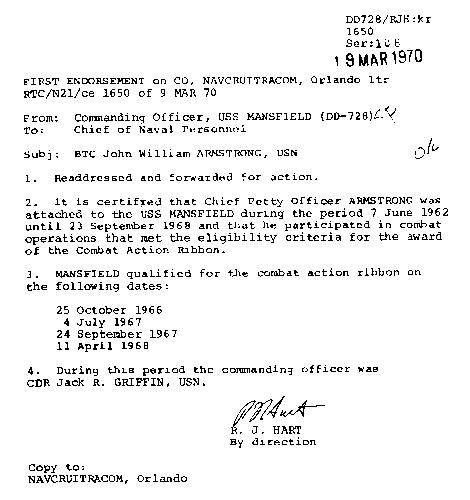
![]()
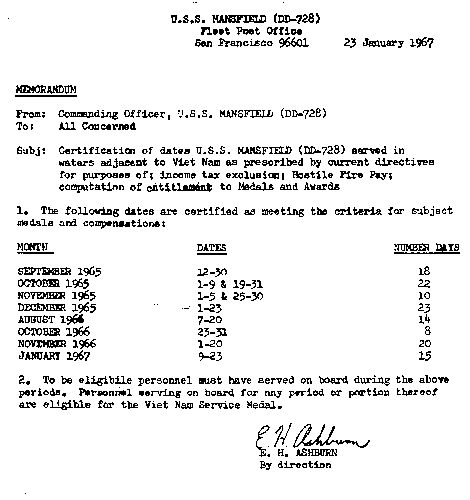
[ Return to Top ] [ Sea Tales Pg.2 ] [ Sea Tales Pg.3 ] [ Sea Tales Pg.4 ] [ Sea Tales Pg.5 ]
XO’s Sea Tales
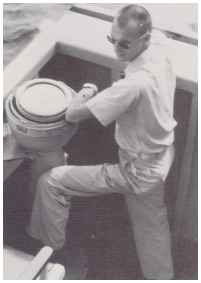 “I was XO under CDR Jack Griffin from May 1967 through October 1968. I was a LCDR at the time. I continued in the Navy until June 1, 1986, when I retired after 29 years, 9 months, as a Captain. Subsequent to Mansfield I commanded USS LOCKWOOD (DE-1064), 1972-74, and the U.S.Naval Station, Subic Bay, 1979-80.”
“I was XO under CDR Jack Griffin from May 1967 through October 1968. I was a LCDR at the time. I continued in the Navy until June 1, 1986, when I retired after 29 years, 9 months, as a Captain. Subsequent to Mansfield I commanded USS LOCKWOOD (DE-1064), 1972-74, and the U.S.Naval Station, Subic Bay, 1979-80.”
“I recall the tragic day off Dong Hoi very well. To add to the lore surrounding that day, I can tell you that the OTC (Officer in Tactical Command) was a new arrival in WestPac. He was a Division Commander of some division and I had worked for him in BuPers back when he was a CDR and I was a LT.”
“You may, or may not recall this, but we ran south at 25 knots on our initial run with “guns free” and were never fired upon. We were at 14,000 yards (average) offshore. As we neared Point Bravo at the end of the firing run, the Commodore signaled ‘Turn 18.’ This was a 180 degree turn to the right. First, we NEVER made turns towards the shore. A steering casualty could land you in the Hanoi Hilton. Second, we NEVER retraced our original track. They had obviously been tracking us on the first run.”
“I credit Captain Griffin with saving lots of lives that day. When the signal to turn was given, Jack got on the 1MC and told everyone that this was going to be bad and he didn’t want anyone standing within six feet of anyone else. Obviously, this wasn’t possible in places like CIC and the bridge, but I’m sure he had Repair 5 in mind, which usually gathered in a group in the middle of the inside fore and aft passageway.”
“PO2 Richard Archer was standing in the open doorway to the wardroom looking aft down the passageway. A piece of shrapnel, about 3/8ths diameter, caught him in the sternum. He died almost immediately despite the Doctor’s best efforts. You may recall that he had just returned from 30 days leave in Hyannis, Mass., where he had been married. He brought a piece of the wedding cake back for the C.O. When we opened Archer’s locker, we found that he was an avid reader of the classics. We collected money from the crew and sent it to the Hyannis library where they dedicated a book shelf (or section, I’m not sure) to the memory of PO Archer.”
“I remember the transit home to Yoko after the hit, the repair availability to get us back in shape, and the return to Dong Hoi. Since I had previously been on the 7th Flt. staff, I went over to the schedulers and told them that we (the C.O. and I) wanted to return immediately to Sea Dragon and Dong Hoi. They obliged and, as I recall, that was our first target when we got back. We waited for the cover of friendly monsoon clouds and went in much closer than ever before and totally destroyed the gun site. (Verified later by a BDA [Bomb Damage Assessment] flight.”
“Mansfield was a good but tired ship. I remember all the problems with the Mark 1A fire control computer, the fluorescent light fixture mounts that would break when we fired all six guns, the gyro that used to periodically tumble, and how the water wash down system became so battered from the shock that we finally took it down. I also remember shooting gun barrels at over 100 percent wear until we finally figured out that it was causing all the premature bursts just beyond the end of the gun barrel. I had been aboard only about two weeks when I went up to the bridge late at night when we were firing. As I stepped into the pilot house we had two prematures out of mount 52. Blinded by the blast, I could only hear the Captain saying, ‘XO, will you come with me to my sea cabin.’ When we got their he asked me to look at his back, below the flack jacket and life jacket, and see what was wrong. He was bleeding and I was able to pick a shiny shaving of shrapnel from a small cut. He had been nicked by our own round! I remember a fleeting thought, ‘Wow!, my first destroyer command after only two weeks as XO!’ Fortunately, it was a very minor cut. I recall, however, looking at the armored face of Mount 52 in the day light and seeing dents that were half the size of a soft ball from our many premature rounds.”
“We sent many messages to COMCRUDESPAC about our prematures and sent many samples of shrapnel that was eventually analyzed as U.S., 5″/38. (Incidentally, analysis of the shrapnel from our hit at Dong Hoi showed it to be 85mm.)”
[ Return to Top ] [ Sea Tales Pg.2 ] [ Sea Tales Pg.3 ] [ Sea Tales Pg.4 ] [ Sea Tales Pg.5 ]



